What Is Wi-Fi 6 Advanced?
Wi-Fi 6 Advanced is a next-generation Wi-Fi technical framework launched by Huawei. Based on the large capacity, low latency, and wide connection of Wi-Fi 6, Wi-Fi 6 Advanced proposes three new features with AI and security as the core: network-wide gigabit, real-time intelligent control, and harmonized IoT and sensing. Wi-Fi 6 Advanced helps build a speedy, stable, and smart wireless network to bring Wi-Fi 6 from office to production, enabling flexible production, unmanned plants, and less-manned production lines.
What Issue Does Wi-Fi 6 Advanced Try to Solve?
Wireless serves as an important means of digital transformation for enterprises. Wi-Fi 6 is changing thousands of industries and has achieved good results in office and other scenarios. As Wi-Fi becomes more and more popular and provides higher performance, its application scenarios will expand significantly. Wi-Fi application scenarios will no longer be limited to the office, but will include production and manufacturing industries such as manufacturing, mining, and healthcare, which poses new requirements on Wi-Fi.
Take manufacturing as an example. The application of Wi-Fi in the manufacturing industry is completely different from that in the office. A typical scenario is automated production, in which equipment such as robotic arms, operates under the control of a unified server. This process requires high reliability and low latency to guarantee real-time service data interaction. Another example is Automated Optical Inspection, also known as AOI. In this scenario, high-definition photos of products are taken and then uploaded to the server for automatic product quality inspection. This process requires ultra-high bandwidth. What's more, factories typically need to deploy an IoT solution for real-time asset stocktaking. Is it possible to integrate wireless and IoT services onto one network to reduce costs?
Facing such a new set of challenges, Huawei launches the Wi-Fi 6 Advanced technical framework. Based on Wi-Fi 6, Wi-Fi 6 Advanced proposes a series of innovative technologies, such as Coordinated Spatial Reuse (CoSR), Fluent-MIMO, air interface slicing, dual fed and selective receiving, and 3D radio calibration. It helps enterprises build speedy, stable, and smart wireless networks, meeting stricter requirements in production and manufacturing scenarios. Wi-Fi 6 Advanced brings Wi-Fi 6 from office to production, enabling flexible production, unmanned plants, and less-manned production lines. These innovative technologies are applied to the office scenario to further improve all-wireless office experience.
Technical Advantages of Wi-Fi 6 Advanced
Based on the large capacity, low latency, and wide connection of Wi-Fi 6, Wi-Fi 6 Advanced proposes three new features with AI and security as the core: network-wide gigabit, real-time intelligent control, and harmonized IoT and sensing.
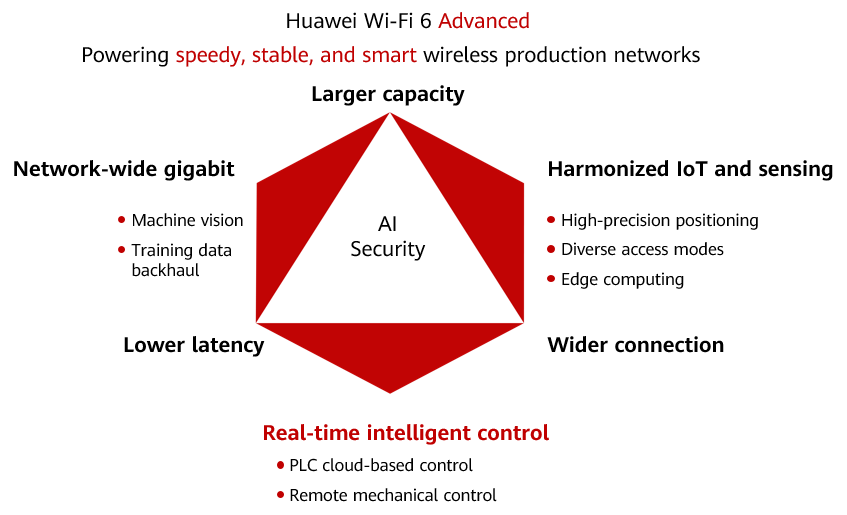
Technical framework of Wi-Fi 6 Advanced
Network-Wide Gigabit
Wi-Fi 6E is an enhanced version of Wi-Fi 6 that introduces the 6 GHz frequency band that provides up to seven additional 160 MHz channels, empowering Huawei's Wi-Fi 6E devices with gigabit speeds. To keep pace with Wi-Fi 6E, Huawei released Dynamic-Zoom Smart Antennas that support the omnidirectional and high-density coverage modes, improving edge performance by 20% when working in high-density coverage mode. Additionally, the innovative CoSR technology can increase the downlink rate by 15%, while another innovative technology Fluent-MIMO can increase the concurrency rate by 20%.
Real-Time Intelligent Control
Huawei proposes three innovations air interface slicing, dual fed and selective receiving, and lossless roaming, to provide ultra-high reliability and ultra-low latency network assurance for real-time services. Air interface slicing can provide ultra-high reliability and ultra-low latency of 99.999% @ 10 ms for periodic services, providing deterministic experience. What's more, the innovative dual fed and selective receiving technology provides 99.999% ultra-high reliability by establishing redundant radio links. As for roaming, lossless roaming technology ensures "zero" packet loss and roaming handover within 10 ms.
Harmonized IoT and Sensing
IoT in production systems is complex, and various subsystems cannot communicate with each other. Huawei launches the Wi-Fi and IoT convergence solution. This solution uses built-in IoT slots, external IoT USB ports, and built-in IoT chips to expand IoT capabilities of APs. It also supports IoT protocols such as Bluetooth, radio frequency identification (RFID), and ZigBee. In addition, some AirEngine Wi-Fi 6 APs support Software-Defined IoT (SD-IoT). The built-in container provides diversified open interfaces, allowing for on-demand expansion of third-party applications. This enables detection for IoT terminal status at the edge and timely data processing.
AI Technology
Wi-Fi 6 Advanced widely applies AI capabilities to Wi-Fi technologies. For example, Huawei launches intelligent radio calibration, which can analyze historical network quality based on Big Data to implement predictive calibration on the entire network, improving network performance by more than 50%. Traditional radio calibration focuses only on APs but ignores actual terminal experience, achieving poor calibration results. To address this, Huawei launched 3D radio calibration that centers on terminal experience to achieve AI-based 3D scenario identification AI and network-wide calibration, improving network performance by more than 20%. AI roaming is another typical application of AI in the WLAN field. This technology replaces the traditional STA-initiated roaming mode with network-steered roaming. The AI algorithm is used to customize differentiated proactive steering policies for each terminal. The terminals are steered to the optimal AP at the optimal time, increasing the roaming terminal speed by 30% and the roaming success rate by 70%.
Innovative Wi-Fi 6 Advanced Technologies
The following are the innovative technologies of Wi-Fi 6 Advanced.
CoSR
This innovative technology coordinates the transmit power of the primary and secondary Access Points (APs) to eliminate interference and increase the secondary APs' gains.
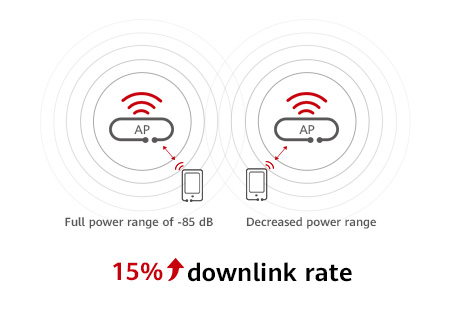
CoSR
Fluent-MIMO
MU-MIMO enhancement improves MU pairing efficiency and improves performance deterioration in mobility scenarios. In this way, MU-MIMO brings significant gains in real service scenarios.

Fluent-MIMO
Air Interface Slicing
Bandwidth reservation and fixed delay capabilities can be provided for specific services through dedicated slicing queues, time synchronization between Access Points (APs), air interface resource reservation, robust scheduling, and uplink packet sending management.
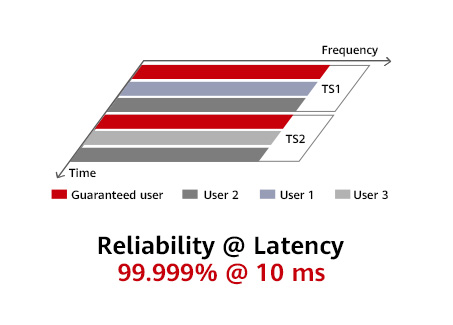
Air interface slicing
Dual Fed and Selective Receiving
Two concurrent data redundant links are established between Customer-Premises Equipment (CPE) and the Access Controller (AC). The redundant links and the first-come-first-served policy optimize packet loss and delay during transmission, ensuring that services are not affected when a single link is faulty, ultimately improving service reliability.
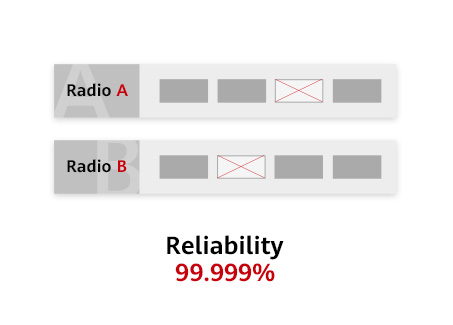
Dual fed and selective receiving
3D Radio Calibration
Based on the downlink measurement of STAs and the feedback of STA experiences, a three-dimensional topology is constructed to comprehensively and truly reflect the propagation of wireless signals in space and the impact of signals on STAs and APs, thereby better adapting to complex and changing spatial environments and improving calibration accuracy.
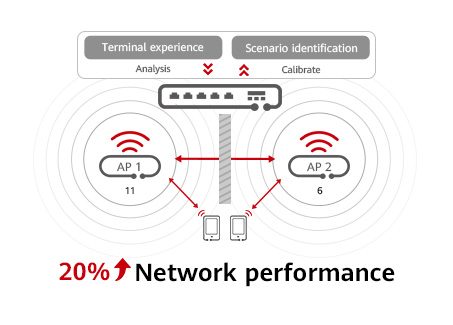
3D radio calibration
Wi-Fi 6 Advanced Application Scenarios
Wi-Fi 6 Advanced can be applied to various production scenarios, such as production lines in the manufacturing industry, mining in the energy industry, and medical IoT in the healthcare industry.
- Author: Zhou Xia
- Updated on: 2023-04-27
- Views: 3347
- Average rating:







